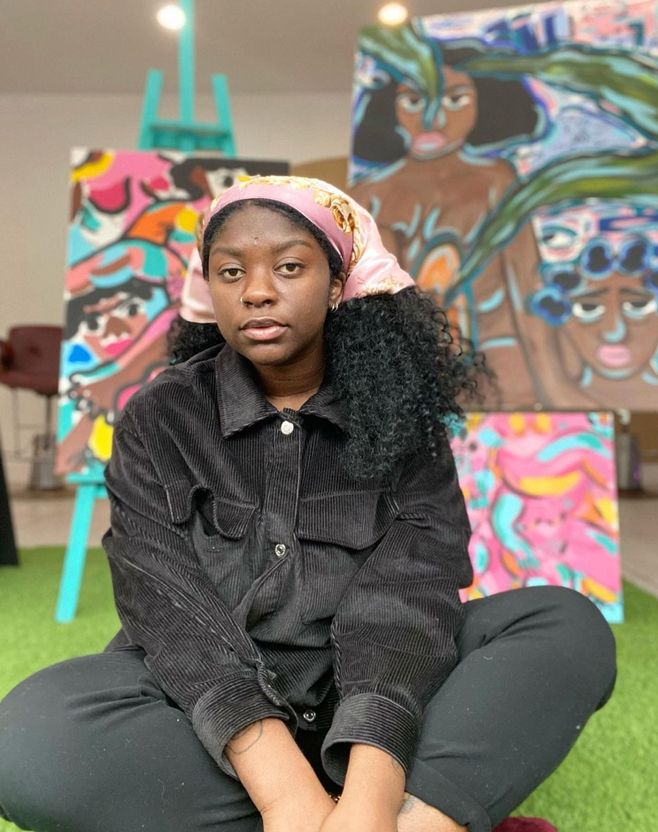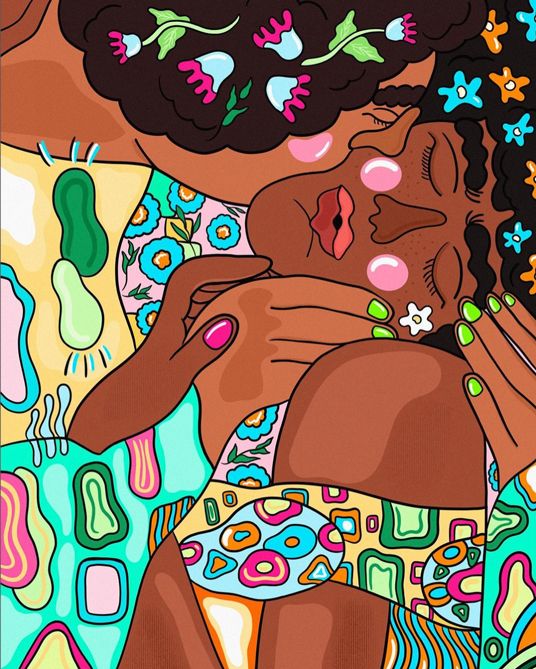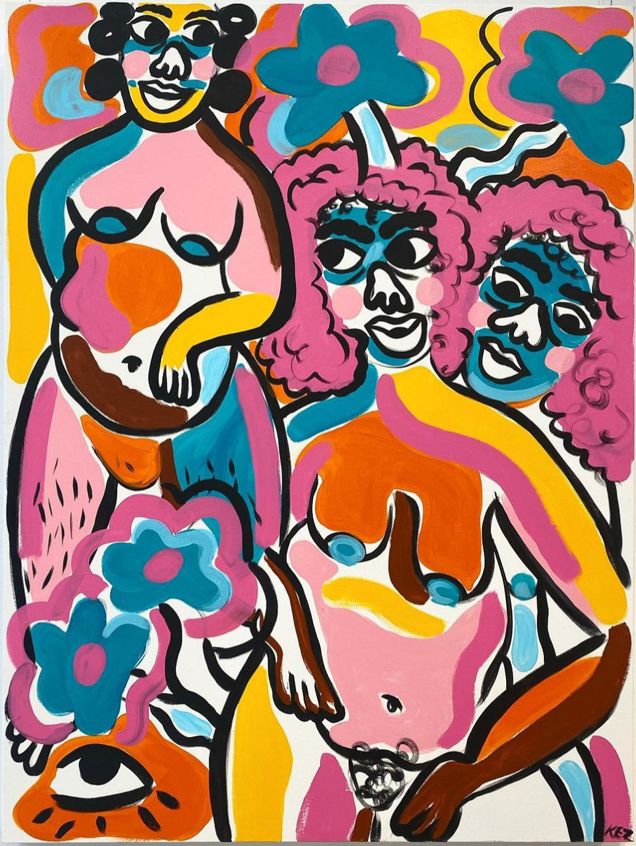Black Artistry Series is a year round program committed to celebrating Black creatives and storytellers around the world. Each month, Arts Help is highlighting impactful projects and publishing exclusive interviews with leaders who are producing inspiring content in support of the Black community. Through this program, we aim to cultivate a platform for these stories to be shared with readers around the world and to celebrate the talent and ingenuity of Black creatives.

This month, Arts Help had the chance to chat with Montreal multidisciplinary artist Kezna Dalz. Also going by the name Teenadult (@teenadultt on Instagram), Dalz is known for her simple and bold lines, bright colours, and empowering images of Black female love and realness. She engages with digital art as well as painting, and the themes she adresses touch on feminism, self-love and self-care, emotional vulnerability and anti-racism.
Apart from exhibiting her paintings and selling her prints, merch, pins, stickers, (and more!) on her website, Kezna Dalz is also part of multiple collaborations and initiatives that work to uplift the Black community. She gave workshops with Montreal-based organizations such as Jeune Queer Youth, a sexual education and awareness program, and Black Joy MTL, a project aiming to improve the social and collective well-being of Black communities. Additionally, Dalz illustrated Shanice Nicole Peaks’ celebratory poem to Black girls entitled “Dear Black Girls” and was the Artistic Director of the 2021 edition of the Massimadi LGBTQ+ Afro film and art festival.
In an interview with Arts Help, Dalz talks about the importance of representation in art and the importance of having faith in institutional change to be a part of the shift towards a more inclusive artistic bureaucracy.
Can you tell me a little bit about how you got started in art?
I was always interested in the arts as a kid. I really liked colours. I took a class when I was around eight or nine and then, in high school, I would take a lot of art classes as options, even if it wasn't a program that existed. So in addition to the classes that were already in my schedule, I added some more art classes.
In CEGEP (pre-university in Quebec) I studied arts for a bit, but then I switched to a program that's more political science aimed — same thing in university. In the meantime, I just never really stopped creating, finding my style, finding what I like. Then I started being contacted by people inviting me to take part in events. From that, it was just like a wheel — people would ask what I would create, I would just create for fun and put it online, and then I would get work until today, where I get enough [work] that I can do that full time.
On Instagram and on your website, you repeatedly mention that your work aims to "promote self care, anti-racism, body positivity and vulnerability.” Why is it important that you express these values through your work, and how do these themes relate to each other?
I think it's important because it will never be talked about and promoted enough. As a queer woman of colour that doesn't necessarily fit in the beauty standards that have been promoted since forever, it's important for me to go against that and to put something different out there that other people can relate to. And that is important. Representation is so important. It's important to me to stick to my values when it comes to body positivity and self-love, but also to denounce racism through my art by representing Black bodies, which you don't necessarily always see in a “beautiful” context in the media, and on social media in general.


Your work was recently on display at the National Institute of Contemporary Art (INAC gallery) in Montreal as part of the exhibition “Dos à Dos, Face à Face” alongside four other inspiring BIPOC artists: Laurena Finéus, Sfiya, Esther Calixte-Bea and Sarah-Mecca Abdourahman. Among other things, you also exhibited at the Quebec National Museum of Fine Arts as part of the Picasso exhibition last year. How would you describe your relationship with museums and galleries — institutions that have historically been (and sometimes continue to be) hostile to Black women?
I think my relationship is mostly one of being aware of all of that. Being aware that throughout history, museums have been hostile towards Black women and towards people of colour, that they also have been stealing history and artwork. So I think it's a relationship of being aware of that and also a relationship where there's hope that they will do better in the future.
I think that the fact that I am at the gallery and that I was at the museum is a step towards them doing a better job, not only by allowing other artists to be in there, but specifically artists who are not white and also artists who are not necessarily famous worldwide — just giving a chance to everybody. I think it's very important. I think that even if it's a complicated relationship, it's important to have hope that these institutions that are very academic can change eventually, do better, and listen to artists that are not white, super old, and mostly men.
The Quebec National Museum of Fine Arts’ exhibition on Picasso worked to highlight one of the greatest artists of the 20th century, while recognizing his troubling past of reprehensible behaviour towards women. For that, they juxtaposed Picasso's work with works like yours, engaging with current social concerns like body diversity. Can you expand on the role you played in the Picasso exhibition?
I think it was firstly to offer a perspective that comes from women and non-gender conforming persons. Picasso was obviously painting from a male gaze throughout his career and representing women not necessarily in the best way. He was also known as abusive towards them as well. I think that my role and the role of other artists was really to offer a more genuine, accurate perspective and gaze of women's bodies, women’s history, and just real womanhood, not through the eyes of an old man who didn't really understand women and who was fetishizing them instead.
I think that if [the Picasso exhibition] hadn't been presented in such a bold and honest way, I wouldn't have wanted to participate. From the start, the person that contacted me was telling me that they were completely acknowledging the fact that [Picasso] was not perfect at all. That he was terribly flawed. I think that it's important that [our art on body diversity] was there because then people who visit Picasso, no matter if they agree or not with the fact that the artist is not being separated from the art fully, at least they can still continue to walk a couple steps and be offered something different.
I also think it’s cool to offer [a part of Picasso’s] big spotlight to artists that are emerging. I feel like it’s a way to make up for the fact that Picasso was always praised.
You also have a series of illustrations that consist of your reinterpretation of famous paintings like The Kiss by Gustav Klimt or The Sleepers by Gustave Courbet. Do you have particular motivations or intentions behind the reinterpretation of famous paintings by white male artists with Black subjects?
First of all, it's very fun for me to do that, but there is also a lot of reappropriation to be made. In classical paintings, most of the Black people that were represented were slaves, servants or [supporting characters] to the whites, and I don't think that's fair. I really like presenting these paintings in another way. All the [paintings] that I choose, I love, but they definitely lack history, so it gives me the opportunity to bring something new to them.
Hopefully, because I love art history, in showing these paintings, people can get to know the artists, but I can also bring my perspective as a Black woman and just be like: “Hey look, it would've been fun if these people were Black, and not only [portrayed] as slaves.”
In workshops, you certainly must give out some advice for aspiring artists of the Black community. How do you approach these workshops, and what kind of advice do you give?
The questions that come up the most are: “Hey, I've never done art before, how do I start?” [I answer with very simple advice]: “literally just do it.”
I feel like a lot of people are stopping themselves from doing art because they're not allowing themselves to, but you can literally go to the dollar store, get the cheapest paint and just do it. Often you think that you can’t do it because you have such a strong idea of what it's supposed to look like, but if you just try and work hard with the idea that anything that’s going to come out is going to be yours, and it's going to be unique, and it's going to be special because you're the one who's doing it.
Some of your works show your support for social movements like “Defund the Police” or “Black Lives Matter”. Would you say you use your art as a form of activism?
I think that because I do works like that, then it is a form of activism. But mostly I do it for myself because these are things that are very close to my beliefs, and it’s therapeutic for me to express my feelings when it comes to the Black Lives Matter movement and anti-racism. When I draw, I use it as a way to process my emotions. For example, when I draw Black women crying, I'm also talking about the Black Lives Matter movement and racism, but it's a more subtle way to approach it.
How can artists such as yourself help to uplift and empower the Black community?
I think by offering representation and accessibility. I feel like a lot of Black folks, including myself, are still struggling to allow themselves to do whatever they want. And I think that just me being an artist and making a living off of it, putting my stuff out there, it can be helpful in a way because it's like “if she's doing that, I can also do that.”
I also think we have to try to let go of the things that we're “supposed” to do or “not supposed” to do. Especially in a lot of immigrant families, it's like “why would you be an artist when you could be like a nurse or a lawyer?” Careers are very strong clichés, but art is just as good. I think that it's important to spread the word that it's okay to do that.
To uplift, it's also important to have spaces where we feel safe and we can just all be together.
I really love spaces where people of colour get to create together and chat and talk about our experiences, and just do something as freeing as creating.
Do you have any future plans or goals for your art?
Eventually, when I'm older, I'd love to have a space where workshops can be hosted, and that is also a gallery. I feel like spaces like that that have their door open can make people realize that they're allowed to be a part of the art community.
Is there anyone (artist, collective, organization, etc.) that you want to shout out?
Oh, yes I love Niti Mueth. She is an amazing illustrator, graphic designer, designer, she literally does anything. I also really like Mallory Lowe, she's a very talented photographer.
There’s also an artist that I really like, Queen Esie on Instagram. She is also a body hair activist. She does very important work alongside being an amazing painting artist. I would like to invite everyone to go see her stuff.
Follow Kezna Dalz on Instagram here.
To support her work, visit her website.
Read other editions of the Black Artistry Series here, and follow the series on social media with the hashtag #ArtsHelp365
